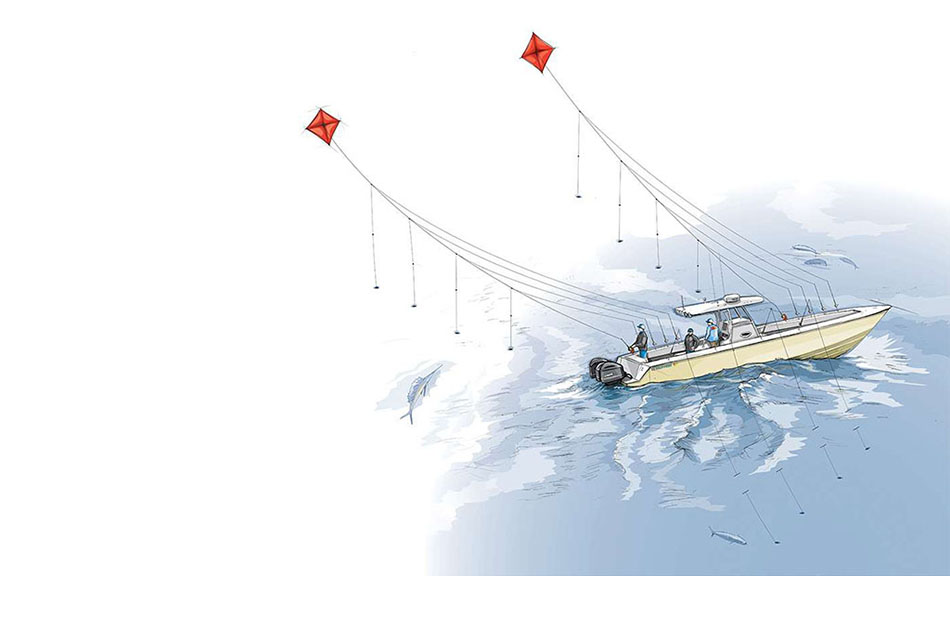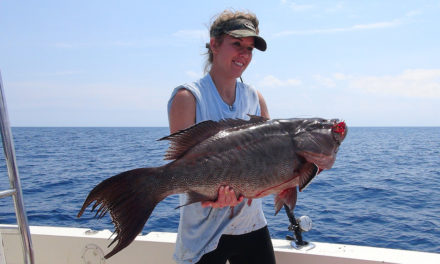When squid and flying fish get pinned against the surface and are scared, they jump! The kite picks the baits out of the water and makes it look like they are jumping.
As I’ve written before, we’ve all experienced the slowdown that happens around 10 a.m. You might have seen my column last month, in which I covered slowing it all down and sending baits deeper during the middle of the day.
Like I said, wahoo don’t have Maui Jims … so they use water depth to get the right amount of light they want and constantly look up to see the silhouette of any given bait. That is precisely why all the dark colors work best, and only the planer rod produces bites during the middle of the day.
Again, who says you have to go 6 knots and have to use a ballyhoo? Slow it down. Fly a kite with artificials, and use big natural baits on the downrigger to get results. A big beautiful squid on the downrigger on a Barefoot Cats and Tackle Chin Weight and a spread of artificial squid or flying fish on the kite, along with the outriggers loaded with natural squid, is a beautiful spread.
With one squid at 50 feet and one at 75 or 100 feet, you are putting an utterly irresistible bait at the depth the fish are. The squid on the downrigger will be the “hot” rod consistently. It’s a complete no-brainer: this is the food they eat at the correct depth.
The kite adds an entirely new dimension to the spread and reality to the spread. When squid and flying fish get pinned against the surface and are scared, they jump! The kite picks the baits out of the water and makes it look like they are jumping. That is why keeping at least one red squid in the spread is a good reason. Also, when a squid is scared, it turns red. So a red squid coming out of the water is another “no-brainer.”
Pancake trolling weights for the downrigger are the way to go. They are slimmer, have less resistance, and have less “blowback” with more speed. Stout release tension is best for this application. The tension should be tight enough to “set the hook” and allow the slack to come tight after the strike. The stinger hook will hook the fish 90 percent of the time with a squid, as the fish almost always eat the back half of the squid to disable the squid’s beak. The beak is the only thing on a squid that could injure a fish.
SALTWATER TACKLE YOU MIGHT WANT TO TRY:
7/0 and 11/0 J-Hook Ching Weights: Target fish include Tuna, Wahoo, Mahi or Common Dolphin, King Mackerel, Wahoo, and more. Easy to rig!
4 oz. Crab Decoy Jig: Target fish for Striped Bass, nearshore Drum, Snook, Grouper, west coast bottom fish, and more.
4 oz. Tuna Squid Decoy Jig: From the eastern, western, Alaskan, and gulf coasts, target fish include: Tuna, Dolphin, Wahoo, Fluke, Flounder, Striped Bass, Seabass, Amberjack (east coast), Yellow Tail (west coast), California White Sea Bass (west coast), Grouper, Snapper, Halibut, Ling cod, and all Alaskan bottom fish.
8 oz. - 12 oz. 10/0 Squid Decoy Jig: Catch BIG Grouper, Amberjack, Giant Stripers, and more.






